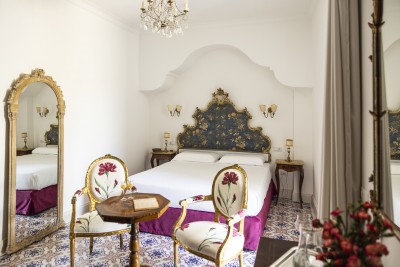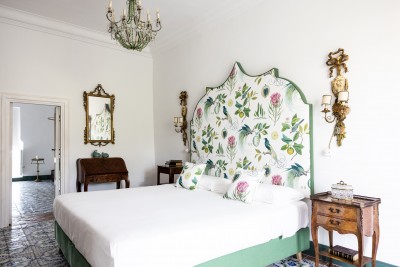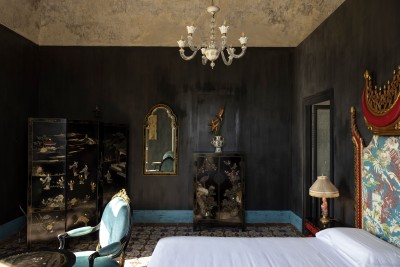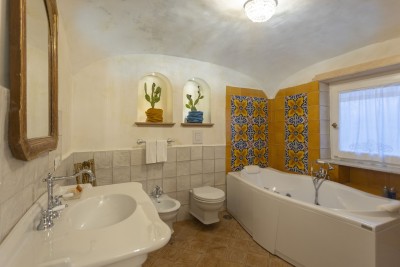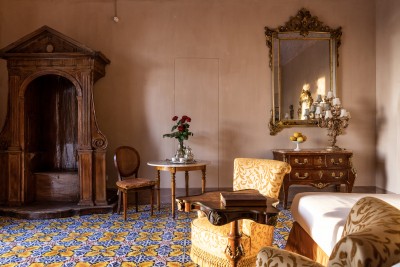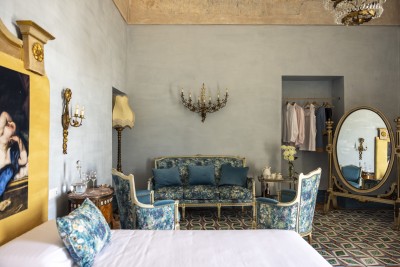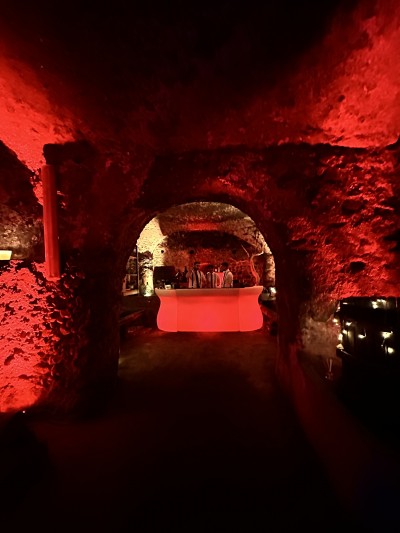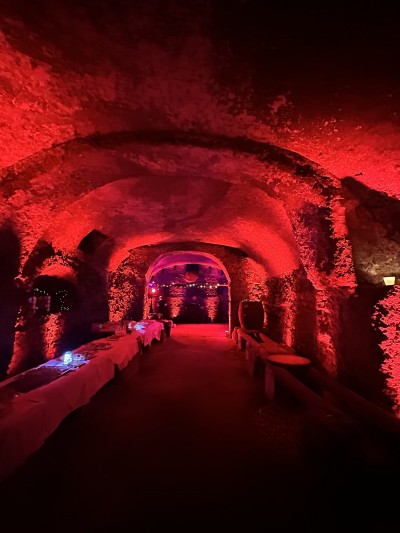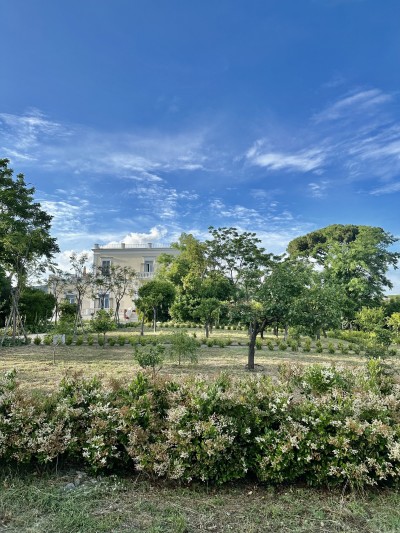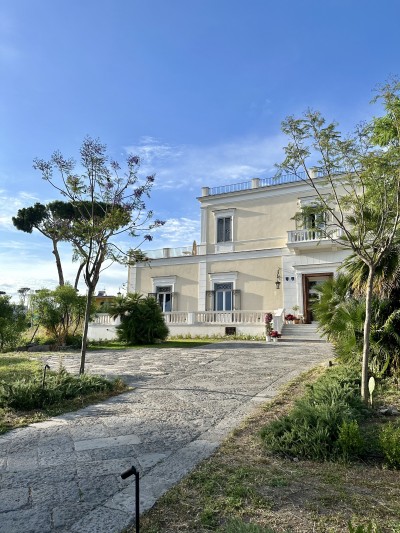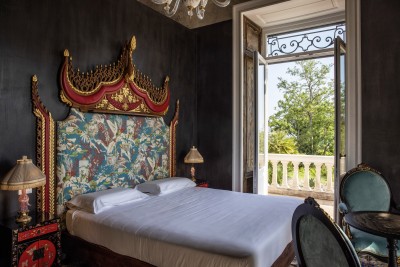Villa De Cillis Carafa is an ancient historic residence, part of the renowned Vesuvian Villas, which once belonged to the noble Carafa D'Andria family. Built in the 18th century, it still retains all its original features and the cellars dug into the lava rock, testimony to its past. In the 19th century, it was transformed from a country farm into a sumptuous summer residence thanks to a major renovation. But it was in 1918 that the Marchesa Eleonora Carafa D'Andria transformed it into the current structure, moving from Naples to Torre del Greco to enjoy the healthy air of the area. Among the three family homes, Villa delle Ginestre, known for having hosted Giacomo Leopardi in the last years of his life, is the most famous. After the Marchioness's death, the villa fell into a state of almost abandonment, until a change of ownership allowed its recovery and return to its ancient splendor. Today, the villa welcomes guests, while remaining a private residence, where the owners usually hold conversations and share convivial moments. Furthermore, it is possible to meet grandfather Michele, who personally takes care of pruning the fruit trees during the early hours of the day.
Contact the abode
VILLA CARAFA DE CILLIS IS AN ANCIENT HISTORICAL RESIDENCE, BUILT IN THE ARCHITECTURAL STYLE OF THE VESUVIAN VILLAS AND LOCATED IN VESUVIUS’ NATIONAL PARK IN THE MUNICIPALITY OF TORRE DEL GRECO, JUST A SHORT DISTANCE FROM THE ANCIENT CITIES OF POMPEII AND HERCULANEUM
Nestled within a one-hectare park adorned with Mediterranean and exotic flora, Villa Carafa de Cillis invites guests to explore the rich history of garden design, encompassing both Italian and English styles. This unique property introduces a novel form of tourism, enabling visitors to immerse themselves in the aristocratic heritage of Neapolitan nobility, while staying at a charming and lovingly restored, eco-friendly residence. A dedicated concierge service is on hand to provide a wide range of experiences, all resolutely rooted in tradition. The overarching theme revolves around Mount Vesuvius and its profound influence, much like it did for the celebrated figures of the past, as championed by Giacomo Leopardi.
THE HISTORY OF VILLA CARAFA DE CILLIS
The original body of the Villa dates back to the 18th century, and it is still possible today to admire the cellars carved into the lava rock from this era. A second major renovation took place in the 19th century, when it was decided to transform the structure from a country estate into a summer residence.
The final significant restoration, which gave Villa Carafa de Cillis its current appearance, was commissioned by Marchesa Eleonora Carafa D'Andria De Cillis in 1918, following the neo-classical Art Nouveau ‘Liberty style’ aesthetics of that era. The Marchesa was the daughter of Riccardo, Duke of Andria and Grandee of Spain, Senator of the Kingdom of Italy, a prolific author of novels and theatrical works, and founder of the magazine "Napoli Nobilissima" with his friend Benedetto Croce in 1892. Her mother, Enrichetta Capecelatro of the Dukes of Castelpagano, served as a lady-in-waiting to Queen Margherita of Savoy. She was a woman of great culture, the author of "La Villa delle Ginestre" and translator of works of Russian authors such as Tolstoy, Gogol, Dostoevsky, Chekhov and Pushkin, published under the pseudonym of Duchess of Andria. Duchess Eleonora spent most of her life between Naples and Torre del Greco, residing in the ancient estates of the Carafa d’Andria family, which also included Villa delle Ginestre, the Torre del Greco residence of Giacomo Leopardi.
During this period, the Villa was embellished with stuccoes, friezes, columns, balustrades, marble and ‘riggiole’ (decorative ceramic tiles), with the creation of a garden that featured many wells and pathways, most of which are now lost or in a dilapidated state. Several objects and structures of significant historical value that were typical of Vesuvian gardens were stolen from the garden, including two wells dating back to the 1500s and 1600s, originating from the early settlements of the De Cillis and Carafa families in the Kingdom of the Two Sicilies.
It was also during this time that the enamelled coats of arms of the four lineages from which the last notables of the Villa descended were created, serving as the basis for recounting the histories of the various room typologies. The Villa was restructured with an L-shaped plan, comprising two above-ground floors and a below-ground floor, all built using lava stone masonry from Vesuvius. The entrance of the building was accessed via an impressive marble staircase, which was slightly elevated and centrally positioned. The mezzanine floor housed the ballroom with its grand fireplace and tapestries, which provided access to the four reception rooms decorated with stucco and damask silk hangings in various colours. The main marble staircase inside led to the ‘piano nobile’ floor, where two terraces, one to the east and another to the west in relation to the central body, added dynamism to the building's lines.
During this period, the Villa became a meeting place for noble Neapolitan families, with a famous literary salon held every Wednesday. The salon attracted personalities such as Princess Casacalenda, the owner of Villa Campolieto on the Golden Mile, Prince Pignatelli, the Marchioness of Serracapriola, Marchioness Bonelli from Pompeii, the Del Balzo counts, as well as numerous literary and cultured figures. Writers, poets and artists were often in attendance, including Benedetto Croce, as Clotilde Marghieri, his neighbour, writes in her novel “Vita in Villa” (‘Life in the Villa’).
Villa Carafa de Cillis, and indeed the entire estate, has historically been a place of very important encounters. In the 1800s, it hosted Romantic literary figures, with Leopardi being the standout among them. Later, it became the location for the Wednesday literary salon and also served as a meeting place for important figures before and during World War II, including Umberto II of Savoy and Mussolini.
Following the bombing on 15 September 1943 that destroyed the Orphanage of Buon Consiglio, located a few kilometres from the Villa, Marchesa Eleonora welcomed Don Raffaele Scauda, the founder of the orphanage, into her home, together with the nuns and the orphaned girls. The guests stayed in the Villa until the Marchesa had the orphanage rebuilt at her own expense.
FACILITIES AND SERVICES: ACCOMMODATION AND PRIVATE EVENTS AT VILLA CARAFA DE CILLIS
The Villa has now been converted into a guesthouse and venue for private events. It provides accommodation in Classic, Deluxe and Suite rooms furnished with period furniture and equipped with all modern amenities. Guests staying at the Villa can take advantage of the communal lounges and terraces, as well as an Italian-style garden. It is also possible to take guided tours starting in the Villa's stone wine cellars and accompanied by a tasting of local products.
Other residence in the region
Offering the same facilities and services
Offering similar experiences
Territory: I Parchi e Giardini Storici - Sud
services
Dimore di charme
Experience in Villa
Stay in one of our original rooms, with original furnishings and views of Vesuvius and the fascinating Capri.
Eventi privati
Villa De Cillis Carafa just for you
Immerse yourself in the magic of the Italian dolce vita with the exclusivity of our villa for your unforgettable event. Ideal for intimate weddings or themed parties, the structure offers a journey through unique emotions.
The Italian garden, embraced by the scents of lemon and orange groves, becomes the first chapter of this sensorial adventure.
The cellar - ancient and dug into the volcanic rock - turns out to be the beating heart of the journey with demijohns, wine presses and earthy details that tell age-old stories.
The panoramic terrace, overlooking the gulf and Vesuvius, becomes the perfect setting for special moments such as cutting the cake or summer parties at sunset.
Our dedicated team will take care of every detail to transform your event into an Italian dream, where each stage is an unforgettable experience.

